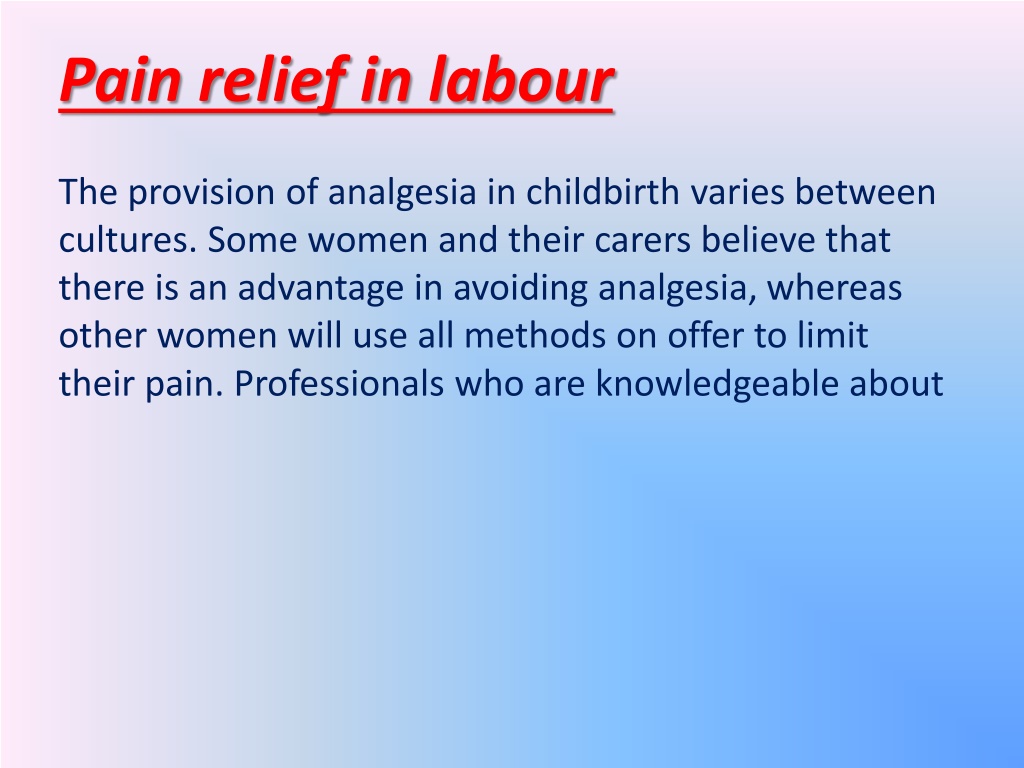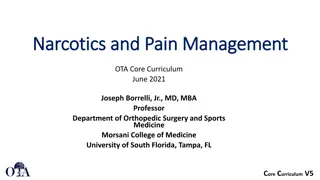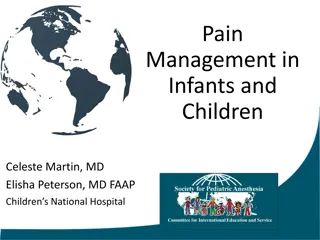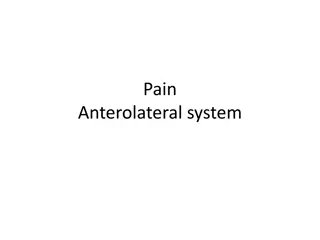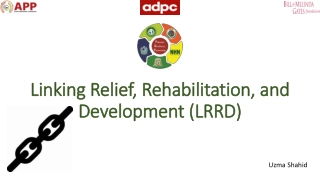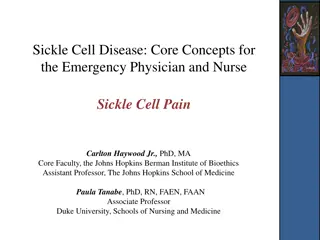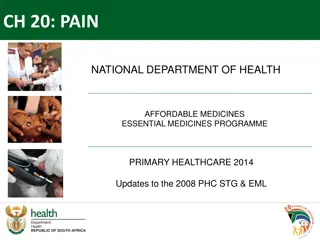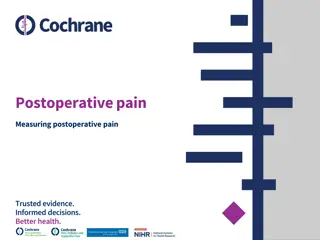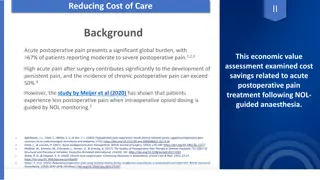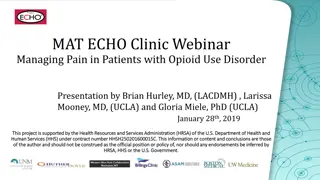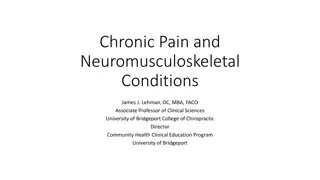Exploring Pain Relief Options in Labor
Provision of analgesia during childbirth varies among cultures, with some women preferring non-pharmacological methods like relaxation, breathing exercises, and warm water immersion, while others opt for pharmacological options such as opiates. Professionals play a crucial role in advising women on pain relief choices, considering individual circumstances and preferences. Non-pharmacological methods like one-to-one care and TENS may reduce the need for analgesia, while opiates offer limited relief but come with possible side effects. The final decision on pain relief rests with the woman, emphasizing the importance of informed choice and personalized care.
Download Presentation

Please find below an Image/Link to download the presentation.
The content on the website is provided AS IS for your information and personal use only. It may not be sold, licensed, or shared on other websites without obtaining consent from the author. Download presentation by click this link. If you encounter any issues during the download, it is possible that the publisher has removed the file from their server.
E N D
Presentation Transcript
Pain relief in labour The provision of analgesia in childbirth varies between cultures. Some women and their carers believe that there is an advantage in avoiding analgesia, whereas other women will use all methods on offer to limit their pain. Professionals who are knowledgeable about
labour and are sympathetic to the labouring woman should give advice regarding pain relief in labour. The method of pain relief is to some extent dependent on the previous obstetric record of the woman, the course of labour and also the estimated length of labour. Just as one woman s labour can be made into an unhappy experience by unsolicited and unnecessary analgesia, pain relief that is inadequate, or offered too late, can ruin another s. It should be remembered that the final decision rests with the woman, although there are certain circumstances in which particular forms of analgesia are contraindicated and should not be offered.
Non-pharmacological methods One-to-one care in labour from a midwife or effective birth partner has been shown to reduce the need for analgesia. Relaxation and breathing exercises may help the woman to manage her pain. Prolonged hyperventilation can make the woman dizzy and can cause alkalosis. Homeopathy, acupuncture and hypnosis are sometimes employed, but their use has not been associated with a signifi cant reduction in pain scores or with a reduced need for conventional methods of analgesia, and they are probably not widely applicable.
Relaxation in warm water during the fi rst stage of labour often leads to a sense of well-being and allows women to cope much better with the pain. The temperature of the water should not exceed 37.5 C. Clearly, a woman in labour cannot use an opiate or have an epidural sited while in water. Transcutaneous electrical nerve stimulation (TENS) works on the principle of blocking pain fi bres in the posterior ganglia of the spinal cord by stimulation of small afferent fi bres (the gate theory). It has been shown to be ineffective in reducing pain scores or the need for other forms of analgesia and should no longer be offered to women in established labour. It does not have any adverse effects, but is often disappointing. It may still be of use in the latent phase of labour.
Pharmacological methods Opiates, such as pethidine and diamorphine, are still used in most obstetric units and indeed can be administered by midwives without the involvement of the medical staff. This may be one of the reasons for their popularity. They should be available in all birth settings but they provide only limited pain relief during labour and furthermore may have significant side effects including: nausea and vomiting (they should always been given with an anti-emetic); maternal drowsiness and sedation; delayed gastric emptying (increasing the risks if general anaesthesia is subsequently required); short-term respiratory depression of the baby; possible interference with breast feeding.
Opiates tend to be given as intramuscular injections, however, an alternative is a subcutaneous or intravenous infusion by a patient-controlled analgesic device (PCA). This allows the woman, by pressing a dispenser button, to determine the level of analgesia that she requires. If a very short-acting opiate is used, the opiate doses can be timed with the contractions. This method of pain relief is particularly popular among women who cannot have an epidural and find non-pharmacological options insufficient.
Inhalational analgesia Nitrous oxide (NO) in the form of Entonox (an equal mixture of NO and oxygen) is used on most labour wards. It has a quick onset, a short duration of effect, and is more effective than pethidine. It may cause light-headedness and nausea. It is not suitable for prolonged use from early labour because hyperventilation may result in hypocapnoea, dizziness and ultimately tetany and fetal hypoxia. It is most suitable later on in labour or while awaiting epidural analgesia.
Epidural analgesia Epidural (extradural) analgesia is the most reliable means of providing effective analgesia in labour. Failure to provide an epidural is one of the most frequent causes of anxiety and disappointment among labouring women. Indications The decision to have an epidural sited should be a combined one between the woman, her midwife,
the obstetric team and the anaesthetist. The woman must be informed about the risks and benefits and the final decision in most cases rests with the woman unless there is a defi nite contraindication. It is important to warn the woman that she may temporarily lose sensation and movement in her legs, and that intravenous access and a more intensive level of maternal and fetal monitoring will be necessary, for example with continuous electronic fetal monitoring (the CTG).
The evidence is now clear that epidural analgesia does not increase Caesarean section rates. However, second stage is longer and there is a greater chance of instrumental delivery, which may be lessened by a more liberal use of oxytocin infusions during second stage in primiparous women with an epidural. In certain clinical situations, an epidural in the second stage of labour may assist a vaginal delivery by relaxing the woman and allowing time for the head to descend and rotate.
The main indication is for effective pain relief. There are other maternal and fetal conditions for which epidural analgesia would be advantageous in labour. These are: prolonged labour, maternal hypertensive disorders, multiple gestation, certain maternal medical conditions, a high risk of operative intervention. The main contraindications are: coagulation disorders, local or systemic sepsis, hypovolaemia, insuffi cient numbers of trained staff (both anaesthetic and midwifery).
An epidural will limit mobility and for this reason is not ideal for women in early labour. However, women in severe pain, even in the latent phase of labour, should not be denied regional anaesthesia.
Complications of regional analgesia Accidental dural puncture during the search for the epidural space should occur in no more than 1 per cent of cases. The needle used for an epidural is wider bore than that used for a spinal. If the subarachnoid space is accidentally reached with an epidural needle, there is a risk that the hole left afterwards in the dura will be large enough to allow the leakage of cerebrospinal fluid. This results in a spinal headache . This is characteristically experienced on the top of the head and is relieved by lying flat and exacerbated by sitting upright.
If the headache is severe or persistent, a blood patch may be necessary. This involves injecting a small volume of the woman s blood into the epidural space at the level of the accidental dural puncture. The resulting blood clot is thought to block off the leak of cerebrospinal fluid. Accidental total spinal anaesthesia (injection of epidural doses of local anaesthetic into the subarachnoid space) causes severe hypotension, respiratory failure, unconsciousness and death if not recognized and treated immediately. The mother requires intubation, ventilation and circulatory support.
Hypotension must be treated with intravenous fluids, vasopressors and left uterine displacement, although urgent delivery of the baby may be required to overcome aorto-caval compression and so permit maternal resuscitation. Spinal haematomata and neurological complications are rare, and are usually associated with other factors such as bleeding disorders. Drug toxicity can occur with accidental placement of a catheter within a blood vessel. This is normally noticed by aspiration prior to injection.
Bladder dysfunction can occur if the bladder is allowed to overfi ll because the woman is unaware of the need to micturate, particularly after the birth while the spinal or epidural is wearing off. Over-distension of the detrusor muscle of the bladder can permanently damage it and leave long-term voiding problems. To avoid this, catheterization of the bladder should be carried out during labour if the woman does not void significant volumes of urine
Backache during and after pregnancy is not uncommon. There is now good evidence that epidural analgesia does not cause backache. Hypotension is now an uncommon complication of epidural anaesthesia, but can still occur with an epidural although more commonly with a spinal. It can usually be rectifi ed easily with fluid boluses, but may need vasopressors. Occasionally, maternal hypotension will lead to fetal compromise (see below). Short-term respiratory depression of the baby is possible because all modern epidural solutions contain opioids which reach the maternal circulation and may cross the placenta.
Spinal anaesthesia A spinal block is considered more effective than that obtained by an epidural, and is of faster onset. A fine gauge atraumatic spinal needle is passed through the epidural space, through the dura and into the subarachnoid space, which contains the cerebrospinal fl uid. A small volume of local anaesthetic is injected, after which the spinal needle is withdrawn. This may be used as the anaesthetic for Caesarean sections, trial of instrumental deliveries (in theatre), manual removal of retained placentae and the repair of diffi cult perineal and vaginal tears. Spinals are not used for routine analgesia in labour.
Combined spinalepidural (CSE) analgesia has gained in popularity. This technique has the advantage of producing a rapid onset of pain relief and the provision of prolonged analgesia. Because the initiating spinal dose is relatively low, this is a viable option for pain relief in labour.
Pudendal nerve block: It is a safe and simple method of analgesia during delivery. Pudendal nerve block does not relieve the pain of labor but affords perineal analgesia and relaxation. Pudendal nerve block is mostly used for forceps and vaginal breech delivery. Simultaneous perineal and vulval infiltration is needed to block the perineal branch of the posterior cutaneous nerve of the thigh and the labial branches of the ilioinguinal and genitofemoral nerves .This method of analgesia is associated with less danger, both for mother and baby than general anesthesia. Technique: The pudendal nerve may be blocked by either the transvaginal or the transperineal route.
Transvaginal route: Transvaginal route is commonly preferred. A 20 mL syringe, one 15 cm (6 ) 22 gauge spinal needle and about 20 mL of 1% lignocaine hydrochloride are required. The index and middle fingers of one hand are introduced into the vagina, the finger tips are placed on the tip of the ischial spine of one side. The needle is passed along the groove of the fingers and guided to pierce the vaginal wall on the apex of ischial spine and thereafter to push a little to pierce the sacrospinous ligament just above the ischial spine tip. After aspirating to exclude blood, about 10 mL of the solution is injected. The similar procedure is adopted to block the nerve of the other side by changing the hands..
Complications: Hematoma formation, infection and rarely intravascular injection or allergic reaction. Toxicity may affect: (A) CNS: excitation, ringing in the ears and convulsions. (B) Cardiovascular: tachycardia, hypotension, arrythmias, even cardiac arrest.
